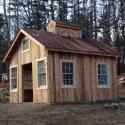
I don't valve any of my lateral lines, 3/16 or 5/16, I only valve mainlines.
To find leaks in 3/16 just watch the sap-air (gases) movement in the line. A leak will show itself because the air leaking in will be seen, usually a fast line of bubbles. If no leaks, the movement will be slow and steady. A leaky tap, or fitting can easily be seen.
Dave Klish, I recently ordered a 2x6 wood fired evaporator from A&A Sheet Metal which I will be converting to oil fired
Now have solar, 2x6 finish pan, 5 bank 7x7 filter press, large water jacketed bottler, and tankless water heater.
Recently bought another Gingerich RO, this one was a 125, but a second membrane was added thus is a 250, like I had.
After running a 2x3, a 2x6, 3x8 tapping from 79 taps up to 1320 all woodfired, now I'm going to a 2x6 oil fired and a 200-425 taps.













 Reply With Quote
Reply With Quote




